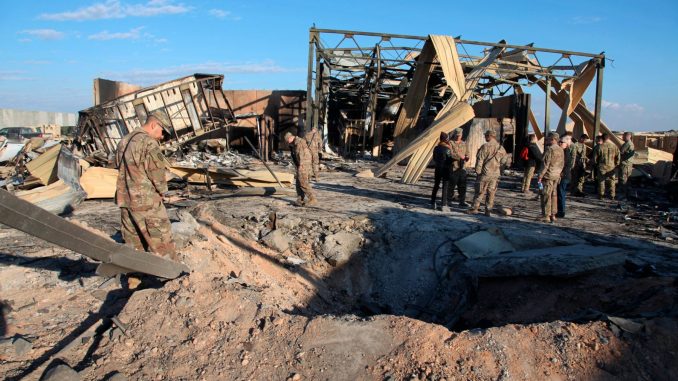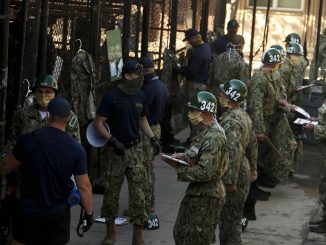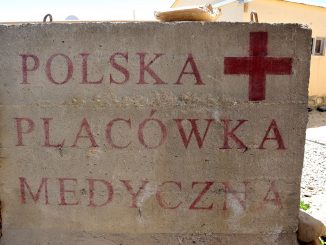

An unspecified number of the more than 100 troops who were treated for traumatic brain injuries suffered in a January missile attack on Al Asad air base in Iraq have been recommended for Purple Hearts, the Pentagon confirmed Wednesday.
Officials have previously stated that Purple Heart recommendations have come from unit commanders and the individual military branches for those injured in the Jan. 8 Iranian missile strikes on the air base.
“The Purple Heart submissions remain under review and are being processed in accordance with Defense Department and military service regulations,” Pentagon spokeswoman Jessica Maxwell said in a statement Wednesday. “Upon completion, service members entitled to receive the Purple Heart will be notified by their leadership.”
She gave no timeline for the process, but CNN, citing three defense officials, reported that “final decisions” on awarding possibly dozens of Purple Hearts could be coming soon from Combined Joint Task Force-Operation Inherent Resolve and the Defense Department.
Related: ‘Emotion and Chaos:’ Air Force Releases Eyewitness Accounts of Al Asad Attack
At a Feb. 3 news briefing, Pentagon chief spokesman Jonathan Hoffman cited general standards for awarding the Purple Heart — standards that appeared to qualify most of the troops who were treated for TBI after the Iranian missile strikes.
He said Purple Heart eligibility for TBI required a doctor’s diagnosis and confirmation that the injury forced the service member to miss at least two days of duty for treatment.
Some of those injured in the Al Asad attack were evacuated to Landstuhl Regional Medical Center in Germany and to the states for treatment and would appear to qualify for Purple Hearts.
Hoffman said recommendations for Purple Hearts were mainly “a question for the services” with final approval coming from the Defense Department.
“The process is going to play out,” he said. “Fortunately, all the cases to date have been characterized as mild TBI, which is the equivalent of concussions.”
In the early years of the wars in Afghanistan and Iraq, the military appeared reluctant to award Purple Hearts for TBI, but awards have been made more regularly as TBI from improvised explosive devices and other blasts became known as the “signature” combat injury of the wars.
In 2011, DoD updated the criteria for awarding the Purple Heart in cases of TBI, stating that the injury had to be caused by enemy action or suffered in action against an enemy, and had to require treatment by a medical officer or certification that it would have required treatment if available.
The Iranian missile strikes on Al Asad were in response to the Jan. 3 U.S. drone strike at Baghdad International Airport that killed Iranian Quds Force leader Qasem Soleimani.
President Donald Trump and Pentagon officials initially said there were no U.S. casualties from the missile strikes on Al Asad, but symptoms of TBI can often take days to appear.
On Jan. 16, U.S. Central Command stated that several of the troops at Al Asad “were treated for concussion symptoms from the blast and are still being assessed.”
When asked about the growing number of concussions, Trump told reporters in Davos, Switzerland, on Jan. 22 that, “I heard that they had headaches and a couple of other things, but I would say and I can report that it’s not very serious. I don’t consider them very serious injuries relative to other injuries that I’ve seen.”
The Pentagon has since said that at least 109 troops at Al Asad on the night of the attacks suffered mild TBI.
In the early morning hours immediately after the missile attacks, and after briefing Trump at the White House, Joint Chiefs Chairman Gen. Mark Milley said off-camera at the Pentagon that the launches “were intended to cause structural damage, destroy vehicles and equipment, and to kill personnel. That’s my own personnel assessment.”
His initial judgment was that the missiles carried 1,000-2,000 pound warheads.
On April 7, Air Forces Central Command published accounts from more than 20 Airmen at Al Asad testifying to the ferocity of the attacks that lasted an estimated 90 minutes.
Capt. Nate Brown recalled taking cover with others in a bunker.
Then, “the next wave hits. Then the next, and the next. I have no idea if anyone is alive outside this bunker.”
— Richard Sisk can be reached at Richard.Sisk@Military.com.
Read More: Navy Orders Deeper Investigation Into Crozier Firing
© Copyright 2020 Military.com. All rights reserved. This material may not be published, broadcast, rewritten or redistributed.





Be the first to comment